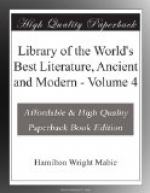“Thammuz
came next behind,
Whose annual wound in
Lebanon allured
The Syrian damsels to
lament his fate
In amorous ditties all
a summer’s day,
While smooth Adonis
from his native rock
Ran purple to the sea,
supposed with blood
Of Thammuz yearly wounded.”
Thammuz is identified with Adonis. “We came to a fair large river,” writes an old English traveler, “doubtless the ancient river Adonis, which at certain seasons of the year, especially about the feast of Adonis, is of a bloody color, which the heathens looked upon as proceeding from a kind of sympathy in the river for the death of Adonis, who was killed by a wild boar in the mountains out of which the stream issues. Something like this we saw actually come to pass; for the water was stained to a surprising redness, and, as we observed in traveling, had discolored the sea a great way into a reddish hue, occasioned doubtless by a sort of minium, or red earth, washed into the river by the violence of the rain.”
The poem is colored by the Eastern nature of its subject, and its rapidity, vehemence, warmth, and unrestraint are greater than the strict canon of Greek art allows. It is noteworthy, aside from its varied beauties, because of its fine abandonment to grief and its appeal for recognition of the merits of the dead youth it celebrates. Bion’s threnody has undoubtedly become a criterion and given the form to some of the more famous “songs of tears”. The laudatory clegy of Moschus for his master—we say of Moschus, although Ahrens, in his recension, includes the lament under ‘Incertorum Idyllia’ at the end of ’Moschi Reliquiae’—follows it faithfully. Milton in his great ode of ‘Lycidas’ does not depart from the Greek lines; and Shelley, lamenting Keats in his ‘Adonais,’ reverts still more closely to the first master, adding perhaps an element of artificiality one does not find in other threnodies. The broken and extended form of Tennyson’s celebration of Arthur Hallam takes it out of a comparison with the Greek; but the monody of ‘Thyrsis’, Matthew Arnold’s commemoration of Clough, approaches nearer the Greek. Yet no other lament has the energy and rapidity of Bion’s; the refrain, the insistent repetition of the words “I wail for Adonis",—“Alas for Cypris!” full of pathos and unspoken irrepressible woe, is used only by his pupil Moschus, though hinted at by Milton.
The peculiar rhythm, the passion and delicate finish of the song, have attracted a number of translators, among whose versions Mrs. Browning’s ‘The Lament for Adonis’ is considered the best. The subjoined version in the Spenserian stanza, by Anna C. Brackett, follows its model closely in its directness and fervor of expression, and has moreover in itself genuine poetic merit. The translation of a fragment of ‘Hesperos’ is that of J.A. Symonds. Bion’s fluent and elegant versification invites study, and his few idyls and fragments have at various times been turned into English by Fawkes (to be found in Chalmers’s ’Works of English Poets’), Polwhele, Banks, Chapman, and others.




